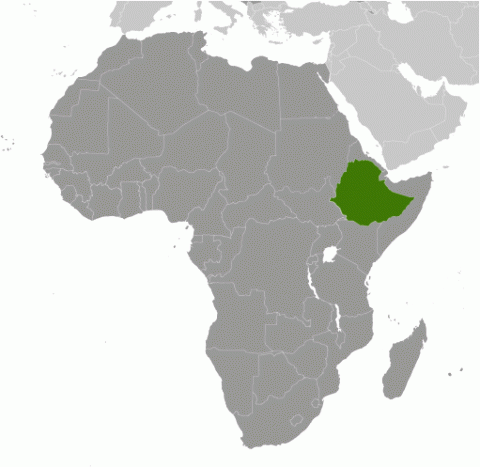Child Labor and Forced Labor Reports
Ethiopia


No Advancement – Efforts Made But Complicit in Forced Child Labor
In 2024, Ethiopia is receiving an assessment of no advancement. Despite initiatives to address child labor, Ethiopia is assessed as having made no advancement because it demonstrated complicity in the use of forced child labor. During the reporting period, there were reports of official negligence related to cases of child soldiers, including forced recruitment into both government and government-affiliated security forces. Due to documentation challenges, it was unclear whether security forces knowingly recruited children. There were at least 14 cases of children having been arbitrarily detained by armed forces to undergo military training in the Oromia region, with one child reportedly as young as 11 years old. In some cases, families were required to pay a large sum of money for the release of their children under the threat that the children would be sent to military training facilities. Otherwise, the government made efforts to eliminate and prevent child labor by establishing a Consolidated Child Protection Case Management Information System alongside the United Nations Children’s Fund. This new information system will work to address the issue of the lack of a centralized data repository which will include data from regions, information on child labor, and protections for sensitive personal identifying information. In addition, the government adopted the Personal Data Protection Proclamation No. 1321/2024 on April 4, 2024, which defines a minor as anyone under age 16 and mandates that processing a minor’s personal data must prioritize their rights, requiring parental or guardian consent. However, despite these efforts, Ethiopia’s laws do not meet international standards because they do not criminalize the use of a child for commercial sexual exploitation, and they allow children ages 15 and 16 to engage in hazardous work. In addition, hazardous work protections do not extend to traditional weaving, a line of work in which there is evidence that children use dangerous machinery, equipment, and tools. Ethiopian law also does not include free basic education or a compulsory age for the completion of education, leaving children vulnerable to the worst forms of child labor. Also, social programs to address child labor do not sufficiently target sectors with high incidences of child labor, including agriculture and domestic work.
| Children | Age | Percent and Population |
|---|---|---|
| Working | 5 to 14 | 24.3% (6,761,640) |
| Boys | 26.6% | |
| Girls | 22.0% | |
| Urban | 6.4% | |
| Rural | 27.7% | |
| Hazardous Work by Children | 15 to 17 | 7.8% (516,740) |
| Boys | 10.7% | |
| Girls | 4.7% | |
| Urban | 6.6% | |
| Rural | 8.0% | |
| Attending School | 5 to 14 | 56.6% |
| Combining Work and School | 7 to 14 | 16.3% |
| Sector/Industry | Percent of Population |
|---|---|
| Agriculture | 76.3% |
| Industry | 2.1% |
| Services | 21.6% |
| Sector/Industry | Activity |
|---|---|
| Agriculture | Farming, including harvesting khat (stimulant plant), forestry, horticulture, herding cattle, and fishing. |
| Industry | Mining† gold, and quarrying.† Producing handicrafts, including traditional handwoven textiles. Manufacturing and construction.† |
| Services | Domestic work and unpaid household services, including carrying heavy loads† of water and firewood. Street work, including shoe shining, weight measurement, vending, and begging. Automobile repair, food services, and transportation. |
| Categorical Worst Forms of Child Labor‡ | Commercial sexual exploitation, sometimes as a result of human trafficking. Forced labor in domestic work, agriculture, forced begging, street vending, construction, and traditional weaving. Forced recruitment and detention of children by state armed groups for use in armed conflict. |
† Determined by national law or regulation as hazardous and, as such, relevant to Article 3(d) of ILO C. 182.
‡ Child labor understood as the worst forms of child labor per se under Article 3(a)–(c) of ILO C. 182.
Children at Higher Risk
Children living on the street are at significant risk of exploitation and abuse and are sometimes recruited by private businesses for child labor and by criminal groups to commit illegal activities. Since the outbreak of the 2020 Northern Conflict, illicit artisanal gold mining has surged across Ethiopia, particularly in northern Tigray. This practice disproportionately involves and affects children, who are informally hired to perform dangerous work and are exposed to toxic chemicals such as mercury and cyanide. Additionally, children face unsafe, unsanitary, and unregulated mining sites, creating extremely hazardous living and working conditions. Further, it is estimated that ongoing internal armed conflict, drought, and flooding has created between 3.5 to 4.4 million internally displaced persons (IDPs). Since March 2024, there have been currently over 1 million refugees and asylum seekers in Ethiopia, including children. Internally displaced children are at higher risk of engaging in child labor due to a lack of educational and economic opportunities. There are cases that indicate that the Ethiopian National Defense Forces and regional military officials forcibly recruited and detained children for the purpose of undergoing military training throughout the Oromia Regional State. There were at least 14 reported cases of children having been arbitrarily detained by armed forces to undergo military training in the Oromia region, with one child reportedly as young as 11 years old. In some cases, families have been forced to pay large sums of money to secure the release of their children from detention centers. In one case, regional military officers detained a 15-year-old boy and told his family that if they did not pay $145 (20,000 birr) for his release, he would have to undergo military training.
Barriers to Education Access
Internal armed conflict, natural disasters, and displacement prevent over 9 million children from obtaining an education in Ethiopia. Research indicates that approximately 10,000 schools have been partially or entirely damaged, and 6,000 schools have been forced to close due to these crises. It is estimated that over 4.5 million children remain out of school in the Amhara region alone due to militarized conflict. Children in the Amhara, Afar, Tigray, and Oromia regions face abduction, kidnapping, sexual violence, unexploded military munitions, and recruitment by armed groups on their way to and from school. The UN verified 12 armed attacks on schools, as well as military appropriation of educational facilities by the Ethiopian National Defense Forces and the Tigrayan forces. In addition, children throughout the country face other barriers to education, including a lack of teachers, lack of sanitary facilities for menstruation, long distances to schools, and corporal punishment in schools. While students with disabilities are not denied access to education, they face additional barriers, including insufficient infrastructure and a lack of trained teachers and professionals to support them. Finally, language barriers present obstacles for many children, especially IDP children, who may not speak the local languages.
| Standard | Age | Meets International Standards | Legislation |
|---|---|---|---|
| Minimum Age for Work | 15 | ✓ | Articles 4.1, 89.1, 89.2, 90, and 186.1(e) of the Labor Proclamation 1156/2019 |
| Minimum Age for Hazardous Work | 15 | ✗ | Article 36.1(d) of the Constitution; Article 89 of the Labor Proclamation 1156/2019 |
| Identification of Hazardous Occupations or Activities Prohibited for Children | ✓ | Articles 89.3, 89.4, and 186.1 of the Labor Proclamation 1156/2019; Directive on the Restating of Activities Prohibited for Young Workers No. 813/2021 | |
| Prohibition of Slavery, Debt Bondage, and Forced Labor | ✓ | Article 18.2 and 18.3 of the Constitution; Articles 596, 597, and 637 of the Criminal Code; Articles 2–4 and 6 of the Prevention and Suppression of Trafficking in Persons and Smuggling of Persons Proclamation No. 1178-2020 | |
| Prohibition of Child Trafficking | ✓ | Article 18.2 of the Constitution; Articles 597 and 635–637 of the Criminal Code; Articles 3.1–3.5 and 4.1 of the Prevention and Suppression of Trafficking in Persons and Smuggling of Persons Proclamation No. 1178-2020 | |
| Prohibition of Commercial Sexual Exploitation of Children | ✗ | Articles 634–636 of the Criminal Code; Articles 3.1–3.5 and 4.1 of the Prevention and Suppression of Trafficking in Persons and Smuggling of Persons Proclamation No. 1178-2020 | |
| Prohibition of Using Children in Illicit Activities | ✓ | Article 525 of the Criminal Code; Articles 3.1–3.5 and 4.1 of the Prevention and Suppression of Trafficking in Persons and Smuggling of Persons Proclamation No. 1178-2020 | |
| Minimum Age for Voluntary State Military Recruitment | 18‡ | ✓ | Article 270 of the Criminal Code |
| Prohibition of Compulsory Recruitment of Children by (State) Military | N/A | ||
| Prohibition of Military Recruitment by Non-state Armed Groups | ✗ | Articles 3.1, 3.2, and 4.1–4.3 of the Proclamation to Provide for the Prevention and Suppression of Trafficking in Persons and Smuggling of Migrants | |
| Compulsory Education Age | ✗ | ||
| Free Public Education | ✗ |
* Country has no conscription
‡ Age calculated based on available information
During the reporting period, the Refugees and Returnees Service issued the Directive to Implement Recognized Refugees’ and Asylum Seekers’ Right to Work No. 1019/2024, which executes the legal protection to work that is granted under Article 26 of the Refugee Proclamation No. 1110/2019. Article 38(2) of the Refugee Proclamation ensures that recognized refugee and asylum-seeker children have rights and protections under relevant laws, including protection from abuse, neglect, exploitation, and trafficking. While Ethiopia has a hazardous work list, the types of hazardous work prohibited for children does not include traditional weaving, a line of work in which there is evidence that children use dangerous machinery, equipment, and tools. Moreover, Article 89.5 of the Labor Proclamation allows children aged 15 and up to engage in certain forms of hazardous work while enrolled in a government-approved and inspected vocational training course. The proclamation’s hazardous work provisions contradicts ILO Convention 138, which prohibits hazardous work for all children under the age of 16. Ethiopia’s laws also do not meet international standards because the use of a child in commercial sexual exploitation is not criminalized. Lastly, while the Ministry of Education has a policy encouraging public funding of education, Ethiopian laws do not guarantee free public education or set a compulsory age for education.
| Organization/Agency | Role & Activities |
|---|
| Ministry of Labor and Skills (MOLS): Conducts labor inspections of formal worksites through its federal and regional Bureaus of Labor and Skills. Through its National Referral Mechanism, MOLS coordinates the referral of survivors to social services providers. In 2024, MOLS conducted monitoring inspections at more than 140 recruitment agencies, leading to 178 sanctions and the revocation of 72 licenses. |
| Criminal Law Enforcement Agencies: The Ethiopian Ministry of Justice prosecutes criminal violations of child labor laws, including through its Special Investigative Unit for Women and Children. The Ethiopian Federal Police Commission also enforces criminal laws against the worst forms of child labor, including child trafficking and the commercial sexual exploitation of children. It addresses child trafficking and assists vulnerable children through its Special Child Protection Units in Addis Ababa. Cases are referred to the Ministry of Women and Social Affairs, which develops and implements programs to protect vulnerable children, maintains rehabilitation centers, and coordinates foster families for children rescued from the worst forms of child labor. During the reporting period, criminal law enforcement agencies enforced the law and trained labor inspectors, child protection experts, police officers, teachers, legal bodies, religious leaders, and parents on protecting children from the worst forms of child labor. The sessions focused on defining child labor and the worst forms of child labor, as well as providing relevant statistics and an overview of the situation of children in Ethiopia. |
| Overview of Enforcement Efforts | 2024 |
|---|---|
| Has a Labor Inspectorate | Yes |
| Able to Assess Civil Penalties | Yes |
| Routinely Conducted Worksite Inspections | Yes |
| Unannounced Inspections Permitted | Yes |
| Has a Complaint Mechanism | Yes |
| Imposed Penalties for Child Labor Violations | Unknown |
| Conducted Criminal Investigations for Worst Forms of Child Labor Crimes | Yes |
| Imposed Penalties for Worst Forms of Child Labor Crimes | Yes |
In 2024, an unknown number of labor inspectors conducted 48,188 worksite inspections, finding an unknown number of child labor violations. The government conducted 26 investigations into suspected cases of the worst forms of child labor, initiated 28 prosecutions, and convicted 6 perpetrators.
| Coordinating Body | Role & Activities |
|---|
| National Steering Committee on the Worst Forms of Child Labor: Develops action plans and coordinates activities to address the worst forms of child labor. Research was not able to determine whether the committee met during the reporting period. |
| Policy | Description & Activities |
|---|
| National Action Plan to Eliminate the Worst Forms of Child Labor (2021–2025): Includes guidelines on child labor identification, withdrawal, reintegration, and education. MOLS did not provide an update on the status of this national action plan for the reporting period. |
| Five-Year Strategic Plan for Migration Management (2021–2025): Aims to prevent and suppress trafficking in persons and smuggling of individuals across borders; to support the safe, humane, and orderly movement of people; and to support efforts to reduce child labor as it occurs in the context of human trafficking and cross-border movement. Research was unable to determine what activities were implemented during the reporting period. |
| Education and Training Policy 2023: Promotes universal, free compulsory education from pre-K to 12th grade. Research was unable to determine what activities were undertaken during the reporting period. |
‡ The government had other policies that may have addressed child labor issues or had an impact on child labor.
| Program | Description & Activities |
|---|
| Freedom Fund: Works to reduce the prevalence of children in domestic work with cooperation from the Government of Ethiopia and the U.S. Department of State’s Office to Monitor and Combat Trafficking in Persons. In 2024, the government assigned personnel in Addis Ababa to conduct joint monitoring visits, which increased the number of children identified and referred to services and rescued from exploitation. Learning spaces for child domestic workers within schools were established, providing comprehensive services to nearly 5,000 children. Legal support led to 42 prosecutions and 19 convictions of perpetrators, and advocacy efforts resulted in the development of the National Alternative Childcare Guideline. |
| Multilateral Projects: The Ethiopia General Education Quality Improvement Program for Equity (2017–2025)‡ is a $583 million World Bank-funded program implemented by the Ministry of Education and development partners to improve education access, as well as the quality of education. In July 2024, the government reached an agreement with the International Monetary Fund to establish a macroeconomic reform program, under which the government expanded funding and support for existing social programs, particularly the Urban Productive Safety Net Program. The government prioritized expanding the existing targeted social safety net as a cost-effective and direct means of providing support to vulnerable families which reduces economic pressures that force their children into work. This mechanism included raising program benefits by 20.7 percent in September 2024, with considerations for additional increases depending on price developments. The government activated a shock response facility to deliver two months of cash benefits to program participants and made efforts to expand program coverage to new program participants, thereby providing more families with the financial stability needed to keep their children in school and out of the labor force. |
‡ Program is co-funded by the Government of Ethiopia.
† The government had other social programs that may have included the goal of eliminating or preventing child labor.
| Area | Suggested Action |
|---|---|
| Legal Framework | Criminally prohibit the use of a child for commercial sexual exploitation. |
| Raise the minimum age at which children may perform dangerous tasks during vocational training to age 16, in line with ILO Convention 138 and prohibit all types of hazardous work for children that require the use of dangerous machinery, equipment, and tools—including those employed in traditional weaving—in compliance with ILO Convention 138. | |
| Criminally prohibit the recruitment of children under age 18 by non-state armed groups. | |
| Ensure that laws providing free basic education include all children in Ethiopia, including non-citizens. | |
| Establish by law a compulsory education age that aligns with the minimum age for employment of 15 years. | |
| Enforcement | Cease the practice of forcibly detaining children for the purpose of military training and recruitment, and investigate cases of military officials involved in the recruitment of children in armed forces. |
| Ensure that children already associated with armed groups are referred to social service providers, and cease the practice of detaining children as adults. | |
| Provide labor inspectors sufficient resources to conduct inspections in all sectors, including with offices, transportation, fuel, personal protective clothing, and equipment for assessing hazardous conditions; increase the number of labor inspectors from 500-600 to 964 to ensure adequate coverage of the labor force of approximately 38.5 million workers; and significantly increase the capacity of labor inspectors by providing additional training on international child labor standards, and strengthen coordination between national and regional enforcement agencies. | |
| Publish labor law enforcement information, including the number of inspectors, inspectorate funding, whether there were targeted routine inspections, and the number of penalties imposed and collected for child labor violations. | |
| Increase funding for criminal law enforcement agencies. | |
| Investigate both domestic and transnational child trafficking cases, prosecute all perpetrators through the judicial system, and raise awareness of the criminality of child trafficking and the worst forms of child labor, including in commercial sexual exploitation. | |
| Coordination | Clarify individual mandates for participants in the National Steering Committee to enhance inter-committee communication, coordination, and collaboration, and increase training opportunities in child protection. |
| Provide adequate funding to coordinating bodies so that they may effectively coordinate activities related to the worst forms of child labor. | |
| Government Policies | Integrate child labor elimination and prevention strategies into the Education Sector Development Program, the National Technical Vocational Education Training Strategy, and the National Youth Policy. |
| Publish activities undertaken to implement key policies related to child labor on an annual basis, including the National Action Plan to Eliminate the Worst Forms of Child Labor, the Five-Year Strategic Plan for Migration Management, and the Education Training Policy. | |
| Social Programs | Repair and reopen school buildings, remove all armed groups from educational facilities, and protect the peaceful gathering of students and teachers for schooling. |
| Increase education access for all children by removing fees for uniforms, supplies, and food; ensuring student safety en route to and from school; ensuring a sufficient number of teachers and sanitation facilities, especially for girls; and abolishing the use of corporal punishment. Finally, accommodate children's different language needs, especially for internally displaced children who may not speak the local language. | |
| Provide training to teachers, and ensure that schools are accessible so students with disabilities are able to attend classes. | |
| Ensure that the social services necessary to prevent and eradicate child labor, such as rehabilitation and reintegration centers, are available throughout the country, and develop or expand social protection programs to address child labor in all sectors, including in agriculture, street work, and domestic work. |







